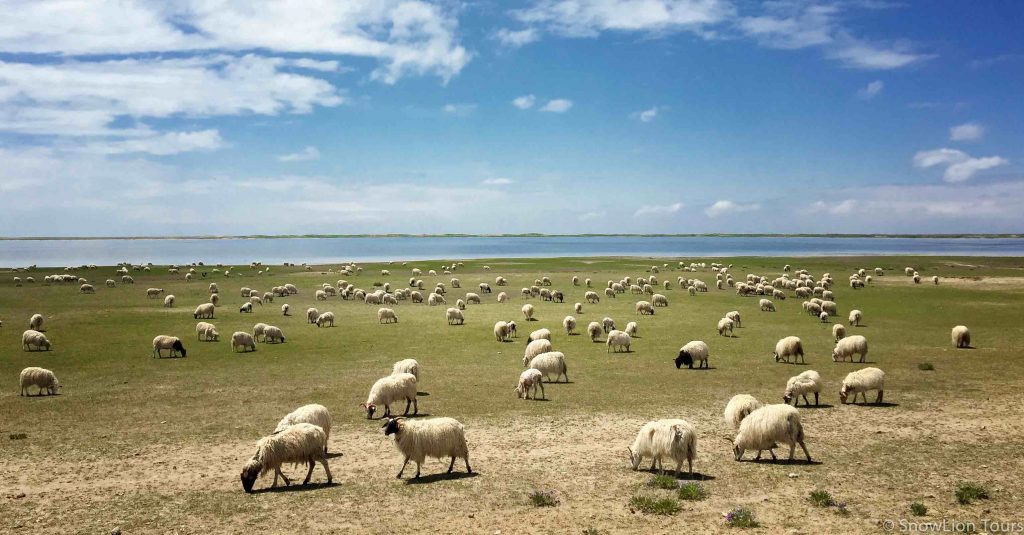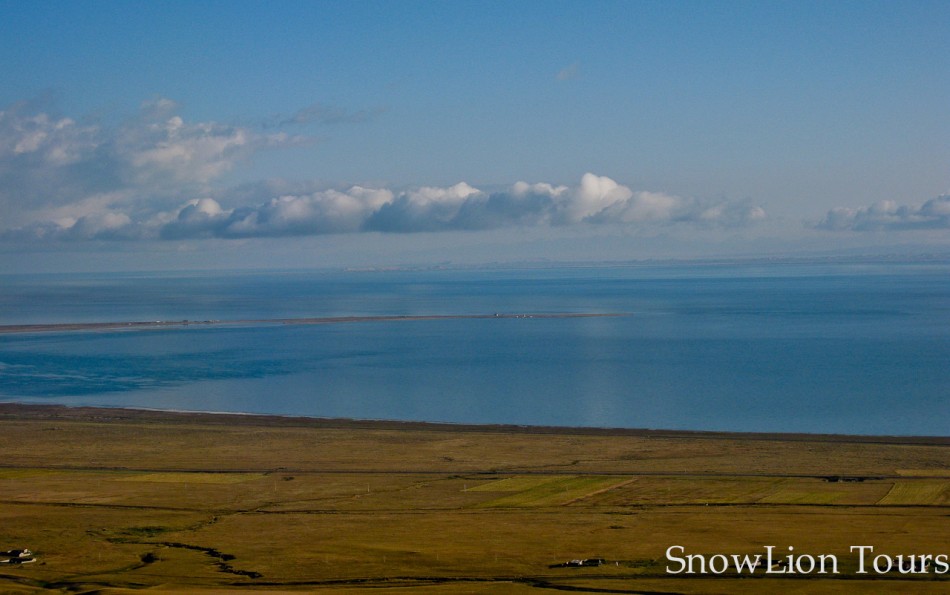Qinghai Lake is on the top 5 most beautiful lakes in China. The following photo is taken in the Island of the lake which is in the center of the lake. It is a Tibetan Buddhist retreat centre as well as small monastery on the top of this about football size island.

This stupa is on the island insde the lake. This island is not part of sightseeing, it’s meditation retreat site.
Qinghai Lake (Tib Tsongongpo, Mogol Lake Kokonor ) is at an elevation of 3200m. The Qinghai Province named after the lake. It is the largest lake in all of China and largest salt lake in Asia. Qinghai Lake is regarded as holy by Tibetans and Mongolians and this is also the sea offering site for Penchen Lama. You can see sea offering site at the south shore of the lake.

Rape seeds flowers of Qinghai Lake southshore
At the south shore of the lake (150km from Xining), take a boat ride on the turquoise waves of the lake or go horseback riding along the shores with Tibetan nomads. If you have an extra day, continue on to the northwest side of the lake (220km from Xining), where you can visit Bird Island, a breeding ground for black-necked cranes, sandpipers, wild geese, and other bird species.
The average depth of the Qinghai lake is 25m and the deepest area goes down to 80m. The perimeter of the lake is 365m. The shores of the lakeand their environs are administered from four counties: Kangtsa(Gangchaxian) in the west and northwest, Haiyanxian(Dabzhidzong) in the northeast, Tongkor(huangyuanxian) in the east and Chabcha(Gonghexian) in the south.

Overview of Qinghai Lake
There are few small monasteries around the Qinghai lake. But the Tsonyang which is a island in the center of the Lake. Tsonyang means “Heart of the lake” is essential Tibetan Buddhism retreat hill. There are only handfull monks and nuns live on this hill and most monks are practice in the retreat cases. These caves have been used by many famous Tibet Yogis and practitioners. Tsonyang Island can be accessible only in the winter time after the lake freezes.

Sheep at the Qinghai Lake
Qinghai lake eco-system has been changed since mass tourists arrive everyday in the summer time. There are more and more restaurants, hotels and shops at both south and north shore. The wild life and nomadic life nearby have been sadly degraded by intensive development of mass tourism and a spread of constructions and transportation. However, the government has investing a lot of money to develop tourism and preserve degraded grassland around the lake. This step can be only proved by the coming years. Hopefully with efforts of government, organizations, travel agency and tourists, we will see more balanced Eco-system in the future.
The best time to travel to Qinghai Lake is from July to September. You will see the nomads move down to the lake and many yaks and sheep scattering around the lake. The fields of yellow rapes seeds in the summer time is one of the highlight and it’s attracts massive tourists in August. However, this time is also the busiest season at the Qinghai lake. Therefore, there are some negative things may need to consider before go there. Hotel and food increasing the price dramatically, you have to make a line due to the number of tourists to visit some of the lake shore tourist sights, noisy everywhere you feel you came to a busy port. But If you visiting Qinghai lake in the summer season, I suggest you go one of the small trail that lead to the lake, you still need to pay entrance fee but half cheaper and less people in these area. Then you can hike up to the mountain to view the whole lake. Since 2013, the nomadic trail may not be possible due to the Qinghai lake management bureau made for big gates in 4 directions before reach the lake, so all the tourists and cars who is heading to the lake has to buy entrance tickets. The Qinghai lake entrance fee is 100Y in 2012 but this may change in 2013.








